Unit 3 Language in use
文档属性
| 名称 | Unit 3 Language in use | 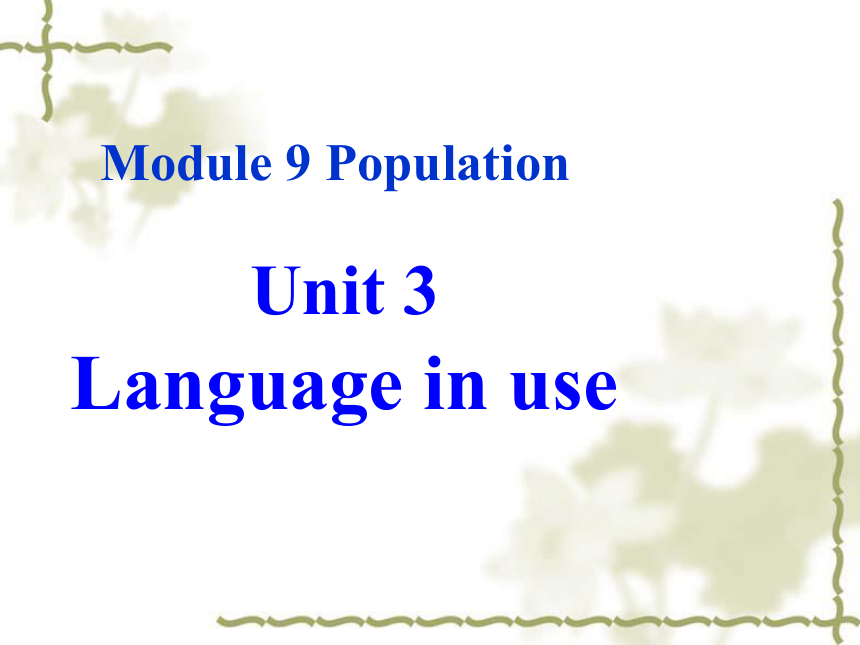 | |
| 格式 | zip | ||
| 文件大小 | 15.3MB | ||
| 资源类型 | 教案 | ||
| 版本资源 | 外研版 | ||
| 科目 | 英语 | ||
| 更新时间 | 2013-09-18 16:24:09 | ||
图片预览

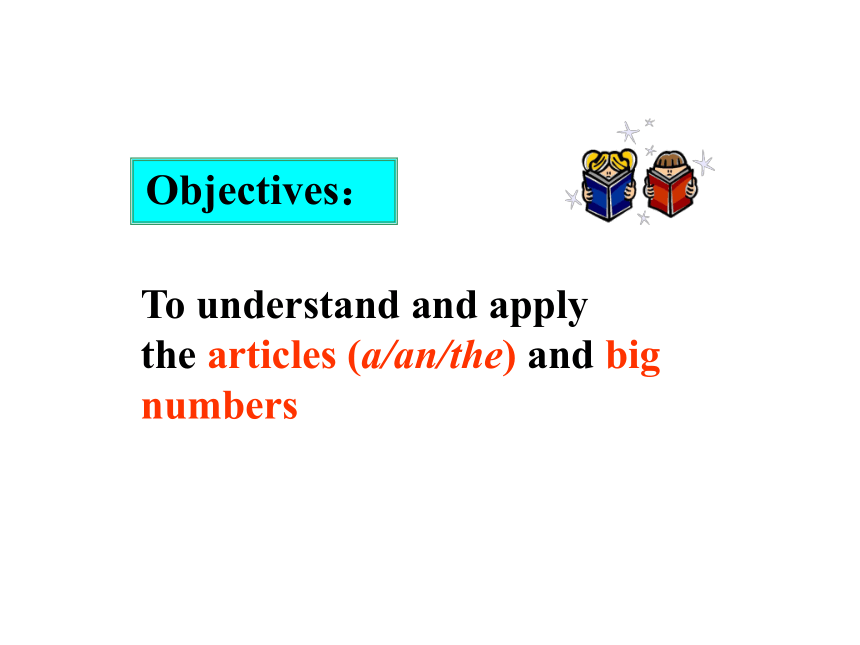
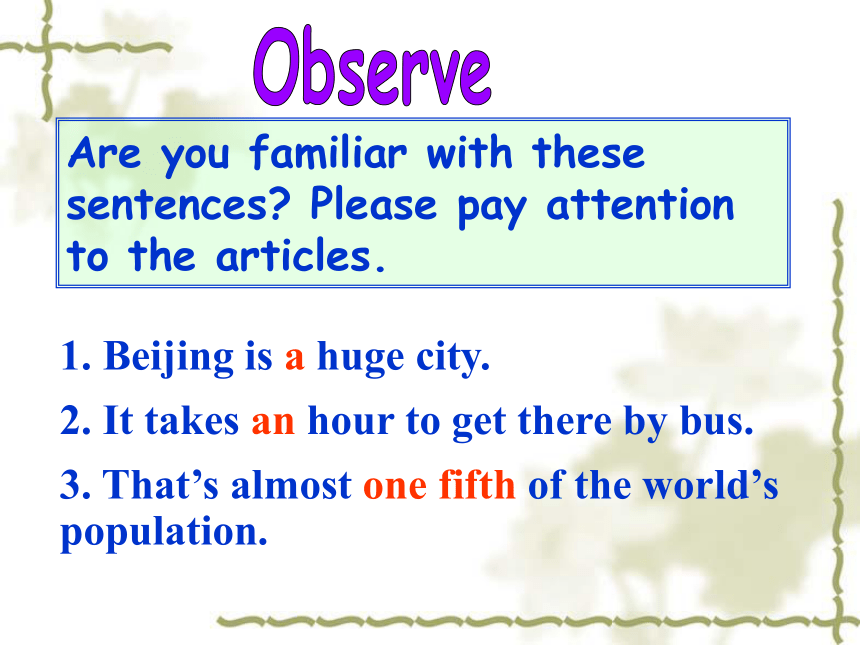
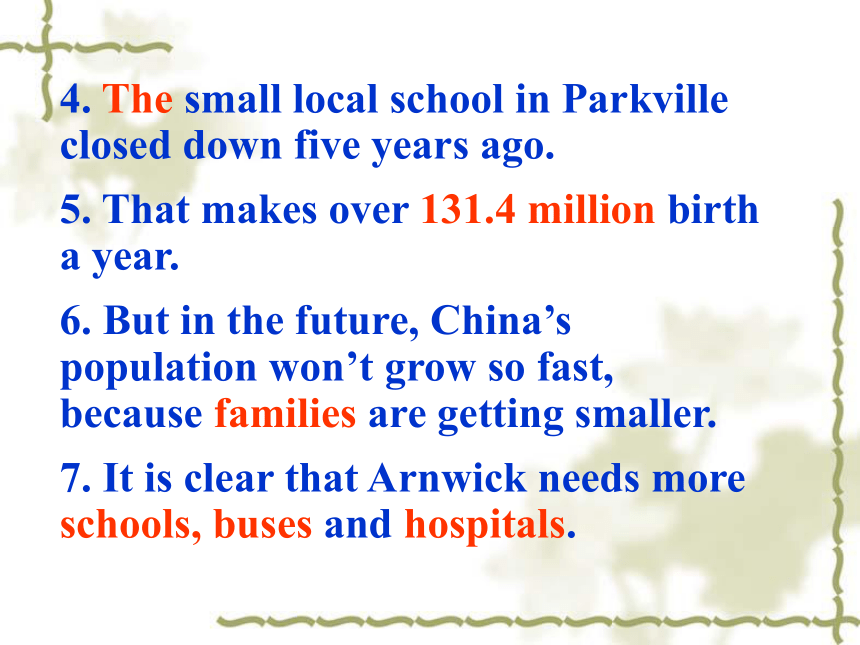
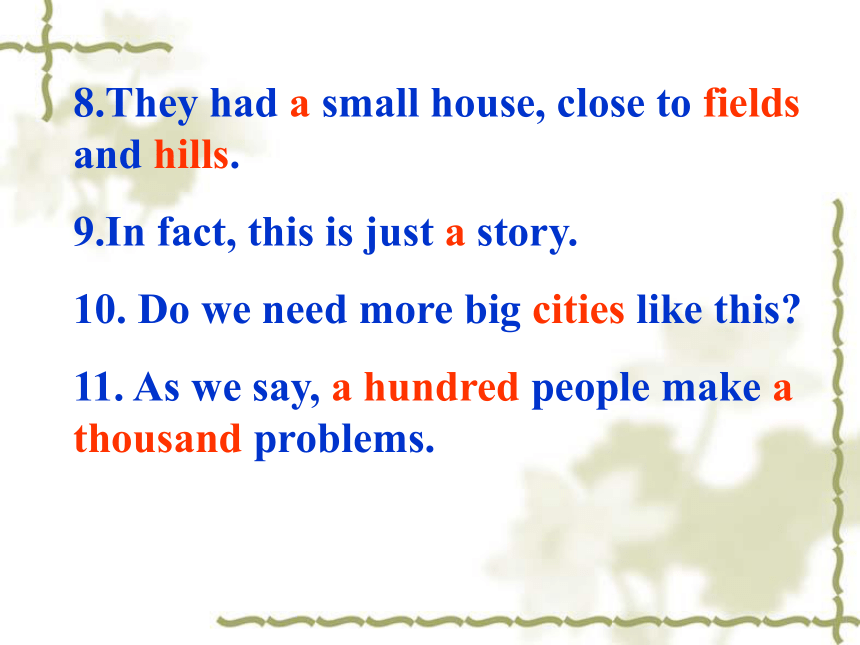
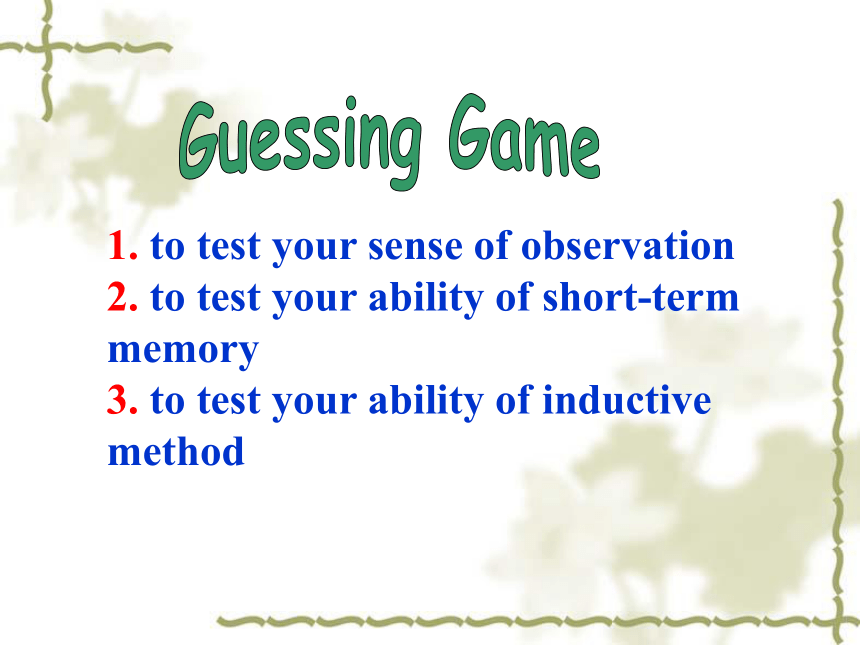
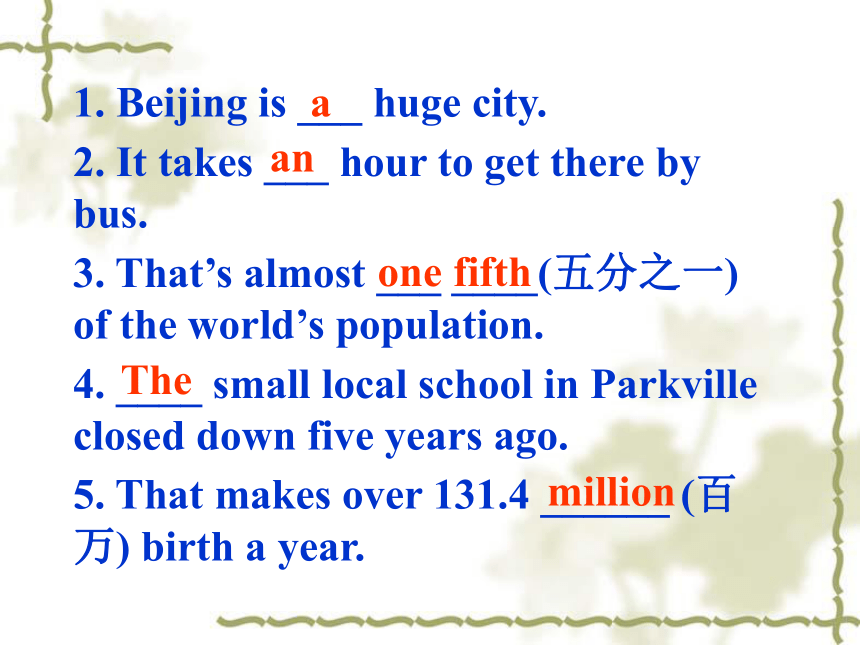
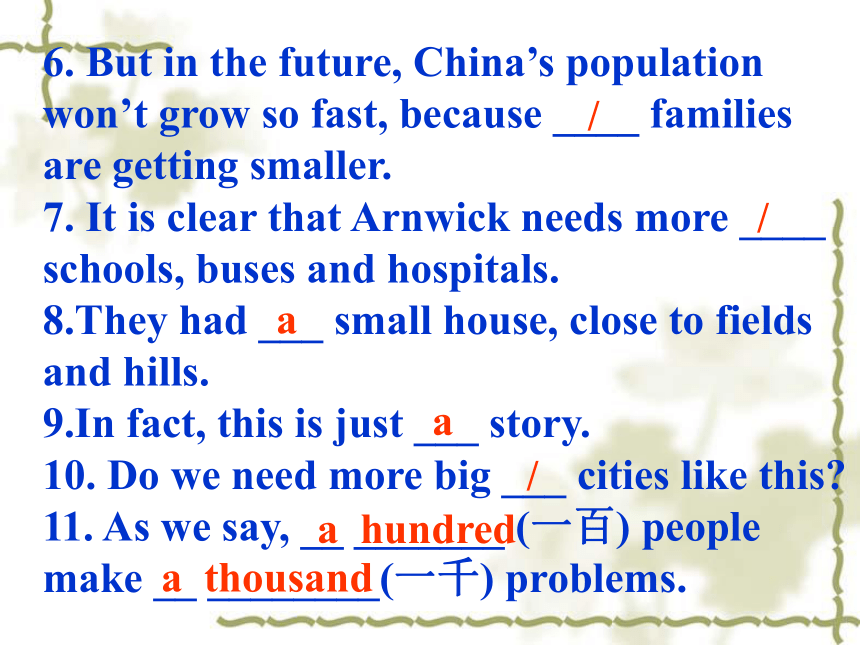
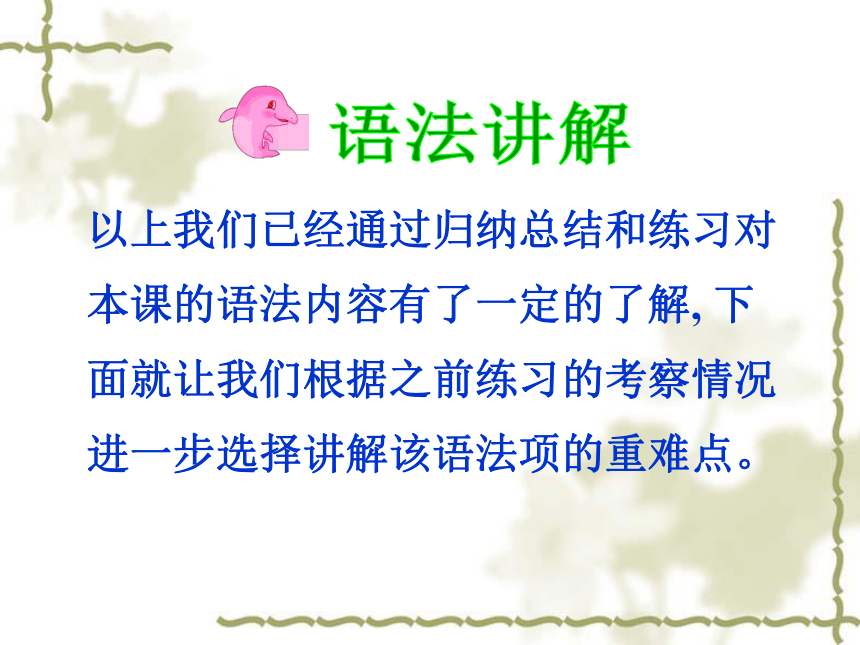
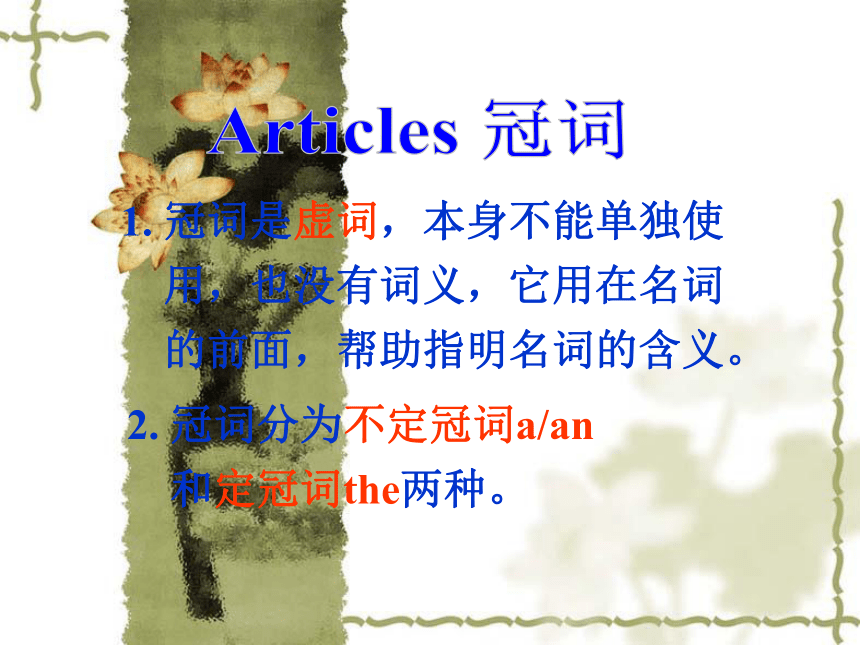
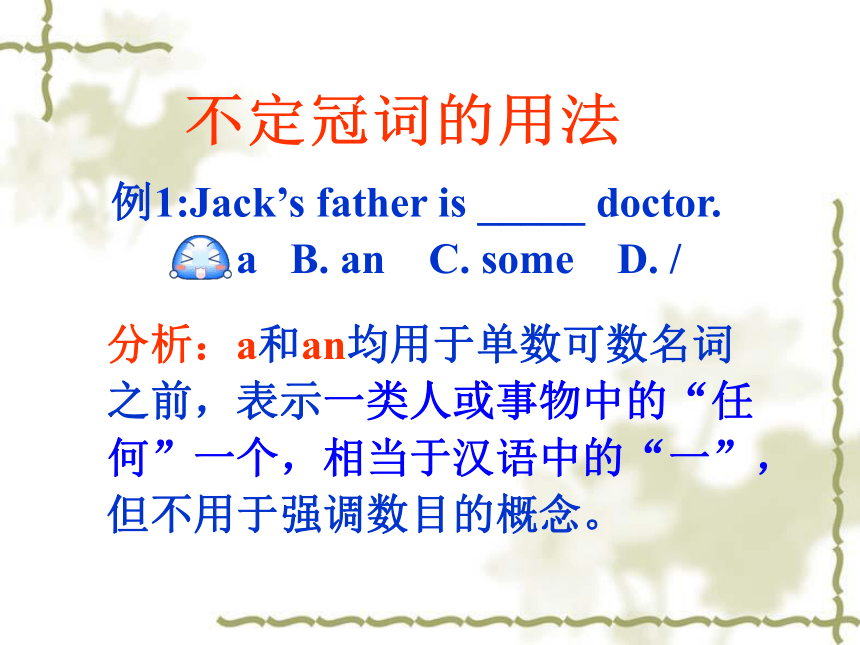
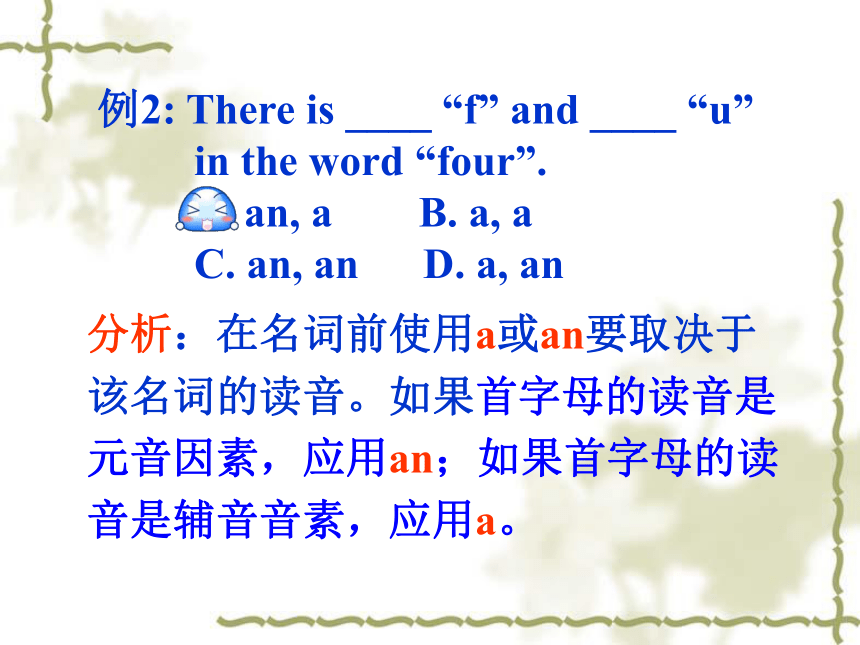
文档简介
课件79张PPT。Unit 3
Language in useModule 9 PopulationObjectives:To understand and apply
the articles (a/an/the) and big numbers1. Beijing is a huge city.
2. It takes an hour to get there by bus.
3. That’s almost one fifth of the world’s population.ObserveAre you familiar with these sentences? Please pay attention to the articles.4. The small local school in Parkville closed down five years ago.
5. That makes over 131.4 million birth a year.
6. But in the future, China’s population won’t grow so fast, because families are getting smaller.
7. It is clear that Arnwick needs more schools, buses and hospitals.8.They had a small house, close to fields and hills.
9.In fact, this is just a story.
10. Do we need more big cities like this?
11. As we say, a hundred people make a thousand problems.Guessing Game1. to test your sense of observation
2. to test your ability of short-term memory
3. to test your ability of inductive method1. Beijing is ___ huge city.
2. It takes ___ hour to get there by bus.
3. That’s almost ___ ____(五分之一) of the world’s population.
4. ____ small local school in Parkville closed down five years ago.
5. That makes over 131.4 ______ (百万) birth a year.aanone fifthThemillion6. But in the future, China’s population won’t grow so fast, because ____ families are getting smaller.
7. It is clear that Arnwick needs more ____ schools, buses and hospitals.
8.They had ___ small house, close to fields and hills.
9.In fact, this is just ___ story.
10. Do we need more big ___ cities like this?
11. As we say, __ _______ (一百) people make __ ________(一千) problems.//aa/a hundreda thousand以上我们已经通过归纳总结和练习对本课的语法内容有了一定的了解, 下面就让我们根据之前练习的考察情况进一步选择讲解该语法项的重难点。语法讲解1. 冠词是虚词,本身不能单独使
用,也没有词义,它用在名词
的前面,帮助指明名词的含义。2. 冠词分为不定冠词a/an
和定冠词the两种。Articles 冠词分析:a和an均用于单数可数名词之前,表示一类人或事物中的“任何”一个,相当于汉语中的“一”,但不用于强调数目的概念。 不定冠词的用法 例1:Jack’s father is _____ doctor.
A. a B. an C. some D. / 例2: There is ____ “f” and ____ “u”
in the word “four”.
A. an, a B. a, a
C. an, an D. a, an分析:在名词前使用a或an要取决于该名词的读音。如果首字母的读音是元音因素,应用an;如果首字母的读音是辅音音素,应用a。1. a, e, i, o, u五个元音字母处于词首
时,未必都是元音音素,u 发音
[ju:]或[ju]前面用冠词a, u读[?]时
前面用冠词an。2. 26个字母中以开头为元音音素发音
的字母有:f [ef], h [eit], l [el], n [en],
r [a:], s [es], x [eks] 。
There is an “R” in the word.
This is a European country.
European词首字母不发音, [j]是辅
音音素。
This is a one-eyed dog.
one [w]是辅音音素。 例3:--Why not take ____ friend
with you?
--That’s ____ good idea.
A. a, a B. the, the
C. a, the D. the, a分析:使用不定冠词指某人或某物,但不具体说明是 何人或何物。例4: Take the medicine three times
____ day.
A. a B. the C. an D./分析:使用不定冠词表示单位,fifty miles an hour 意为“每小时50公里”,twice a week 意为“每周两次”。例5: English is _____language. It is
_____ important tool.
A. a, a B. a, an
C. the, an D. a, /分析:a language意为“一种语言”。language是可数名词。例6: ______ steel worker makes steel.
A./ B. A C. This D. That分析:a(an)放于单数的可数名词前表
示“一类”。该句中 a steel worker是指
钢铁工人们。表示一类有三种方式:
A bike is slower than a car.
The bike is slower than the car.
Bikes are slower than cars.例7:Tom has ____ high fever and his
mother is looking after him.
A. a B. the C. an D./分析: 表示生什么病前应用a, have a headache, have a cold。例8:Mary takes ____ walk after supper
every day.
A. the B. a C. / D. one分析: give, take, have与一些动词名
词化的词连用,表示一次动作,名
词前要加a。
have a talk (bath, look); make a living (promise); take a swim (walk, rest)
give a talk (whistle, smile)例9:The old woman had____ fire in her
room.
A. the B. / C. a D. this分析: 抽象名词和物质名词的具体化时,该名词前要加a。
It is a great joy to study at this college.
This kind of wood can make into a good paper.
He made a living by selling newspaper.例1: There is ___bridge over the river.
___ bridge is made of stone.
A. a, A B. a, The
C. the, The D. the, A 分析: 文章中第一次出现的可数名词
前用a(an)。下次再出现此名词则用the。
I have a little bird. The bird is yellow.定冠词的用法例2: ___ old workers under that tree
are from Shanghai.
A. The B. An C. This D. That分析:名词后有表示范围、地点的介词短语限定时, 名词前应加the来表示特指。
The boys here are interested in sports.例3: ____ first one sat down and the
second stood up.
A. The B. A C. One D. An分析: 序数词前表示顺序时前加the。
Mary is the third to come in.例4: Winter is ____ coldest season of the
year.
A. a B. the C./ D. so分析: 形容词最高级前及Only修饰的名词前均要加 the。
Mary is the only girl who is often late for class.例5: ___ moon moves around ___ earth,
and they both are smaller than
____ sun.
A. The, the, the B. A, an, a
C. The, an, the D. The, the, a分析: 定冠词用于表示世界上独一无二的物体名词前。例6: We live in ____ south of China.
A. the B./ C. a D. some 分析: 表示东、南、西、北方的名词前要加the。
The sun rises in the east.例7: ____ browns are watching TV at
home at the moment.
A. / B. The C. Mr. D. A分析: the放于姓氏的复数形式前时,表示一家人或一姓的夫妇二人。例8: He will go to see you off at ___
Railway Station.
A. a B. an C. the D. /分析: the+普通名词构成专有名词。
the United States/the United Nations
the People’s Republic of China例9: I was playing ____ piano at eight
yesterday morning.
A. a B. / C. the D. this分析: play+乐器表示弹奏时,该乐器名
词前加 the。
Alice likes to play the violin while Kate
likes to play the flute.
表示数量时可用a。
This is a new piano against the wall.例10:Our teacher gets up early in ____
morning.
A. the B. / C. a D. an分析: 牢记一些含the的习惯用语,在句中用作时间状语。
in the afternoon (evening)/
in the daytime
at the beginning/in the end例11:There is a large ship in ____middle
of the river.
A. a B. / C. the D. any分析: 牢记一些含the的习惯用语,在句中用作地点状语。
on the right (left) /in the front of
in the middle of the meeting /
the forest / at the foot of the hill例12:Last night we went to ____
cinema.
A. the B. a C. / D. those分析: 牢记一些固定搭配:
go to the concert (theatre)例13: ____ young should care for and
help ____ old.
A. The, a B. The, the
C. A, the D. An, an分析: the+形容词(形容词名词化)
表示一类人或事物。
the poor / the rich / the sick /
the beautiful例14: The small town lies on ____
Yangtzi River.
A. a B. an C. / D. the分析: 定冠词the用在江河、海洋、 山脉、湖泊、群岛名称的前面。
the Dead Sea / the Black Sea
the North China Plain 华北平原例1:Paper is made of ____ bamboo.
A. a B. the C. / D. that分析: 物质名词和抽象名词前一般不加冠词。
Wood can be made into chairs and tables.
Iron is a kind of metal.零冠词的用法 例2: ____ January is the first month
of the year.
A. The B. A C. / D. That分析: 表示节日、月份的名词前一般
不加the。Spring is coming.
He was born in December.
如果表示有某年限定的季节和月份时,季节和月份前要加the。
He was born in the Summer of 1964.例3: We have no classes ____ Sundays.
A. the B. these C. / D. those分析: 表示一周中七日的名称前一般不加冠词。例4: I studies ___English in___ England.
A. /, / B. an, the
C. an, an D. /, the分析: 学科前和国名、洲名前一般不加
冠词。
learn Chinese (maths, physics, chemistry)
China is in Asia.
in Germany (Japan)
in Africa (Europe …)例5: They often take a walk in ____
Hyde Park.
A. the B. a C. / D. this分析: 在一些专有名词(地名、节假日)之前不加冠词。
Christmas Day New year’s Eve
National Day Children’s Day
Teachers’ Day Wall Street例6:The thief was thrown into ___ prison.
A. the B. a C. this D. /分析: 表示某一概念,而不是某具体工作的部门时,名词前不加冠词。例7: He doesn’t have ____ breakfast at
home.
A. a B. the C. this D. /分析: 表示三餐的名词前不加冠词,如果前面有形容词修饰该词,表示
“一顿……的饭”,可加a。
have a big supper (nice lunch)例8:We go to work by __ bus.
A. / B. a C. the D. one分析: 表示交通工具的手段时,用by+名词表示,该名词前不用冠词。by bike (taxi, car, train, plane, spaceship)或by sea (water, air, land)
如果用介词in或on,名词前要加冠词或物主代词。例9: ____ running is good.
A. The B. A C. / D. An 分析: 动名词前一般不用冠词。
Walking on the moon is difficult.
Seeing is believing.例10:These boys play ____ football
after class.
A. a B. the C. that D. /分析: 球类、棋类、游戏名称前不加冠词。例11:The students of ____ Grade One are
having a meeting.
A. these B. / C. a D. an分析: 名词+数词表示顺序时,前面不加冠词the;序数词+名词表示顺序数,序数词前加冠词the。
turn to page 3 / the third page
Lesson One / the first lesson
gate Five / the fifth Gate例12:There is no ____ book on the
desk.
A. the B. a C. an D. /分析: 名词前有物主代词、指示代词、不定代词、名词所有格或any和no时,均不再用冠词。如:
no books, not a book, not any books例13:He often works late at ____ night.
A. / B. the C. a D. all分析: 表示时间或地点的一些介词+名词的词组和一些固定词组中,均不加冠词。
at home, in town, at noon, at daybreak, in trouble, in danger, in fact等。注意:
有些名词前用冠词或不用冠词,其意义有所不同。如:
1) at table 在吃饭
at the table 在桌子旁
2) in class 在上课
in the class 在班级中3) go to school 去上学
go to the school 到那所学校去
4) go to bed 上床睡觉
go to the bed 到床那边去
5) in front of 在…的前面
in the front of 在…的前部1. 表示一类人或事物中的“任何”
一个,相当于汉语中“一”,
但不用于强调数目的概念。
2. 指某人或某物,但不具体说明
是何人或何物。
3. 表示单位。
4. 表示“一类”。不定冠词的用法Summary1. 文章中第一次出现的可数名词前
用a /an。下次再出现此名词时。
2. 名词后有表示范围、地点的介词
短语限定时。
3. 序数词前表示顺序时。
4. 形容词最高级前及only修饰的名词
前。
5. 定冠词用于表示世界上独一无二的
物体名词前。定冠词的用法6. 表示东、南、西、北方的名词前
7. 姓氏的复数形式前时,表示一家人
或一姓的夫妇二人。
8. the+普通名词构成专有名词。
9. play+乐器表示弹奏时,该乐器名
词前加 the。
10. the+形容词(形容词名词化)
表示一类人或事物。
11. 定冠词the用在江河、海洋、山脉、
湖泊、群岛名称的前面。1. 物质名词和抽象名词前一般不加冠词。
2. 表示节日、月份的名词前一般不加the。
3. 表示一周中七日的名称前一般不加冠词。
4. 学科前和国名、洲名前一般不加冠词。
5. 在一些专有名词(地名、节假日)
之前不加冠词。
6. 表示某一概念,而不是某具体工作的
部门时,名词前不加冠词。
7. 表示三餐的名词前不加冠词。零冠词的用法8. 表示交通工具的手段时,用by+名词表
示,该名词前不用冠词。
9. 动名词前一般不用冠词。
10. 球类、棋类、游戏名称前不加冠词。
11.名词前有物主代词、指示代词、不定代
词、名词所有格或any和 no时,均不再
用冠词。
12.表示时间或地点的一些介词+名词的词
组和一些固定词组中,均不加冠词。
13.家庭成员的称呼、称呼语或只一人担任
的职务名词前不用冠词。
英语分数的表示法:
用“基数词+序数词”表示,其中基数词表示分子,序数词表示分母。分子除用one外,也可用a;如果分子大于1,分母要用复数形式。
Two thirds of the students have passed the exam.?三分之二的学生考试及格了。注意:1/2不能说a(one)second,而要说a(one)half。
1/4和3/4可以说a(one)fourth和three fourths,但常用a quarter和three quarters表示。
若它们在句子中作主语,则谓语动词是用单数还是复数取决于名词,即与分数所修饰的名词保持一致。
About two thirds of the students attend the meeting.
大约2/3的学生都参加了会议。 在英语中,对于万以上的数字,我们改如何表达呢?这就要记住英语数字读法特点。以下面一个数字为例:6,500,431,729hundredthousandmillionbillion注意每三个数为一个单位,按照百、
十、个向下读。大数字的表达方法6,500,431,729seven hundred and twenty-nine thousandmillionbillionsix
billion,five hundred million,four hundred and thirty-one thousand,hundredWork in pairs. Match the countries with their populations.China
the US
Australia
New Zealand 4,437,000
22,956,000
314,791,000
1,370,537,000Read your answers to the whole class.
China has a population of…Now listen and check.12Read the chart and answer the questions.31. Which city had the largest population in 2000?
2. Which city’s population will increase the most from 2000 to 2025?
Tokyo had the largest population in
2000.Mumbai’s population will increase
the most from 2000 to 2025.3. Which city will have a larger increase in its population, New York or Mexico City?
4. Which city / cities do you think will have the biggest population problem? Why? Mexico City will have a larger increase in its population.I think Mumbai will have the biggest population problem because its population will increase the fastest.Mina is (1)____ eighteen-year-old girl. She has got (2)___ brother and (3)___ sister. Mina is (4)____ oldest child in (5)___ family. She lives in (6) ___ very big city. She has (7)____ job in (8) ___ hotel. She hopes that one day she will have (9) ____chance to go to (10)____ college. Complete the passage, with a, an or the where necessary.anaathethe aaaa/4Complete the sentences with the correct form of the words in the box.5few good much small1. We believe the schools in Arnwick are very good, and we are working to make them even ______.better2. Their flat is too large for two people. They want to find a ______ one.
3. Anna always talks about her ideas. I think she needs to listen _____.
4. There are a lot of parks in this city. I think there are ______ parks in a lot of other cities.smallermorefewerComplete the passage with the words in the box.countryside pollution
population space traffic7 Our world is facing many problems. Two of the biggest are
increasing population and pollution. The (1)__________ of the world is increasing quickly. Why is this happening? Because more babies are born every year and people also live longer. Many people are leaving the (2)___________ to work in the cities, but there is not enough (3) _______ for so many people.populationspacecountrysideAnother huge problem for the world is (4)_________. There is so much (5) _______ on the road that in some cities the air is heavily polluted. We should work harder to protect our world.pollutiontrafficReview复习定冠词、不定冠词和零冠词的用法。
复习大数字的表达方法。Making a graph Module task: Step 1: Work in groups. Prepare to make your graph.Choose a country or town which interests you. It could be your home town.
Decide the points of time you want to look at—for example, now, ten years ago and ten years from now.
Research the population of your place in those years. Write your notes carefully.Step 2: Make your graph.
Decide how you want to make your graph.
Draw it and colour it. You can also make it on the computer.
Label it clearly.
Step 3: Write a paragraph to describe your graph.注: word 文档
点击此处链接1.There’s no air or water on ____ moon.
2. ____ Yellow River is ____ second longest
river in ____ China.
3. My mother bought me ___ very nice bike.
I like ____ bike very much.
4. Xiao Ming likes playing ____ basketball,
but he doesn’t like playing _____ piano. the The the a the / the /Quiz I. 填入正确的冠词。5. The students don’t have classes in ___ afternoon on ____ Saturday.
6. I often watch TV in ___ evening.
7. Let’s go out for ____ walk.
8. What would you like for lunch, __ coffee or __ milk? the / the a / /II. 用英语“读”出下列数字。
如:485 → four hundred and eighty-five
1. 846 →
2. 4,517 →
3. 59,248 →
4. 8,326,000 →
5. 9,368,600,000→ eight hundred and forty-six four thousand, five hundred
and seventeen fifty-nine thousand, two hundred and forty-eight eight million, three hundred and twenty-six thousand nine billion, three hundred and sixty-eight million, six hundred thousand Summarize what we have learnt in this module and preview the next.HomeworkPreviewTo preview the new words of next module
To search some information about weatherThank you.
Language in useModule 9 PopulationObjectives:To understand and apply
the articles (a/an/the) and big numbers1. Beijing is a huge city.
2. It takes an hour to get there by bus.
3. That’s almost one fifth of the world’s population.ObserveAre you familiar with these sentences? Please pay attention to the articles.4. The small local school in Parkville closed down five years ago.
5. That makes over 131.4 million birth a year.
6. But in the future, China’s population won’t grow so fast, because families are getting smaller.
7. It is clear that Arnwick needs more schools, buses and hospitals.8.They had a small house, close to fields and hills.
9.In fact, this is just a story.
10. Do we need more big cities like this?
11. As we say, a hundred people make a thousand problems.Guessing Game1. to test your sense of observation
2. to test your ability of short-term memory
3. to test your ability of inductive method1. Beijing is ___ huge city.
2. It takes ___ hour to get there by bus.
3. That’s almost ___ ____(五分之一) of the world’s population.
4. ____ small local school in Parkville closed down five years ago.
5. That makes over 131.4 ______ (百万) birth a year.aanone fifthThemillion6. But in the future, China’s population won’t grow so fast, because ____ families are getting smaller.
7. It is clear that Arnwick needs more ____ schools, buses and hospitals.
8.They had ___ small house, close to fields and hills.
9.In fact, this is just ___ story.
10. Do we need more big ___ cities like this?
11. As we say, __ _______ (一百) people make __ ________(一千) problems.//aa/a hundreda thousand以上我们已经通过归纳总结和练习对本课的语法内容有了一定的了解, 下面就让我们根据之前练习的考察情况进一步选择讲解该语法项的重难点。语法讲解1. 冠词是虚词,本身不能单独使
用,也没有词义,它用在名词
的前面,帮助指明名词的含义。2. 冠词分为不定冠词a/an
和定冠词the两种。Articles 冠词分析:a和an均用于单数可数名词之前,表示一类人或事物中的“任何”一个,相当于汉语中的“一”,但不用于强调数目的概念。 不定冠词的用法 例1:Jack’s father is _____ doctor.
A. a B. an C. some D. / 例2: There is ____ “f” and ____ “u”
in the word “four”.
A. an, a B. a, a
C. an, an D. a, an分析:在名词前使用a或an要取决于该名词的读音。如果首字母的读音是元音因素,应用an;如果首字母的读音是辅音音素,应用a。1. a, e, i, o, u五个元音字母处于词首
时,未必都是元音音素,u 发音
[ju:]或[ju]前面用冠词a, u读[?]时
前面用冠词an。2. 26个字母中以开头为元音音素发音
的字母有:f [ef], h [eit], l [el], n [en],
r [a:], s [es], x [eks] 。
There is an “R” in the word.
This is a European country.
European词首字母不发音, [j]是辅
音音素。
This is a one-eyed dog.
one [w]是辅音音素。 例3:--Why not take ____ friend
with you?
--That’s ____ good idea.
A. a, a B. the, the
C. a, the D. the, a分析:使用不定冠词指某人或某物,但不具体说明是 何人或何物。例4: Take the medicine three times
____ day.
A. a B. the C. an D./分析:使用不定冠词表示单位,fifty miles an hour 意为“每小时50公里”,twice a week 意为“每周两次”。例5: English is _____language. It is
_____ important tool.
A. a, a B. a, an
C. the, an D. a, /分析:a language意为“一种语言”。language是可数名词。例6: ______ steel worker makes steel.
A./ B. A C. This D. That分析:a(an)放于单数的可数名词前表
示“一类”。该句中 a steel worker是指
钢铁工人们。表示一类有三种方式:
A bike is slower than a car.
The bike is slower than the car.
Bikes are slower than cars.例7:Tom has ____ high fever and his
mother is looking after him.
A. a B. the C. an D./分析: 表示生什么病前应用a, have a headache, have a cold。例8:Mary takes ____ walk after supper
every day.
A. the B. a C. / D. one分析: give, take, have与一些动词名
词化的词连用,表示一次动作,名
词前要加a。
have a talk (bath, look); make a living (promise); take a swim (walk, rest)
give a talk (whistle, smile)例9:The old woman had____ fire in her
room.
A. the B. / C. a D. this分析: 抽象名词和物质名词的具体化时,该名词前要加a。
It is a great joy to study at this college.
This kind of wood can make into a good paper.
He made a living by selling newspaper.例1: There is ___bridge over the river.
___ bridge is made of stone.
A. a, A B. a, The
C. the, The D. the, A 分析: 文章中第一次出现的可数名词
前用a(an)。下次再出现此名词则用the。
I have a little bird. The bird is yellow.定冠词的用法例2: ___ old workers under that tree
are from Shanghai.
A. The B. An C. This D. That分析:名词后有表示范围、地点的介词短语限定时, 名词前应加the来表示特指。
The boys here are interested in sports.例3: ____ first one sat down and the
second stood up.
A. The B. A C. One D. An分析: 序数词前表示顺序时前加the。
Mary is the third to come in.例4: Winter is ____ coldest season of the
year.
A. a B. the C./ D. so分析: 形容词最高级前及Only修饰的名词前均要加 the。
Mary is the only girl who is often late for class.例5: ___ moon moves around ___ earth,
and they both are smaller than
____ sun.
A. The, the, the B. A, an, a
C. The, an, the D. The, the, a分析: 定冠词用于表示世界上独一无二的物体名词前。例6: We live in ____ south of China.
A. the B./ C. a D. some 分析: 表示东、南、西、北方的名词前要加the。
The sun rises in the east.例7: ____ browns are watching TV at
home at the moment.
A. / B. The C. Mr. D. A分析: the放于姓氏的复数形式前时,表示一家人或一姓的夫妇二人。例8: He will go to see you off at ___
Railway Station.
A. a B. an C. the D. /分析: the+普通名词构成专有名词。
the United States/the United Nations
the People’s Republic of China例9: I was playing ____ piano at eight
yesterday morning.
A. a B. / C. the D. this分析: play+乐器表示弹奏时,该乐器名
词前加 the。
Alice likes to play the violin while Kate
likes to play the flute.
表示数量时可用a。
This is a new piano against the wall.例10:Our teacher gets up early in ____
morning.
A. the B. / C. a D. an分析: 牢记一些含the的习惯用语,在句中用作时间状语。
in the afternoon (evening)/
in the daytime
at the beginning/in the end例11:There is a large ship in ____middle
of the river.
A. a B. / C. the D. any分析: 牢记一些含the的习惯用语,在句中用作地点状语。
on the right (left) /in the front of
in the middle of the meeting /
the forest / at the foot of the hill例12:Last night we went to ____
cinema.
A. the B. a C. / D. those分析: 牢记一些固定搭配:
go to the concert (theatre)例13: ____ young should care for and
help ____ old.
A. The, a B. The, the
C. A, the D. An, an分析: the+形容词(形容词名词化)
表示一类人或事物。
the poor / the rich / the sick /
the beautiful例14: The small town lies on ____
Yangtzi River.
A. a B. an C. / D. the分析: 定冠词the用在江河、海洋、 山脉、湖泊、群岛名称的前面。
the Dead Sea / the Black Sea
the North China Plain 华北平原例1:Paper is made of ____ bamboo.
A. a B. the C. / D. that分析: 物质名词和抽象名词前一般不加冠词。
Wood can be made into chairs and tables.
Iron is a kind of metal.零冠词的用法 例2: ____ January is the first month
of the year.
A. The B. A C. / D. That分析: 表示节日、月份的名词前一般
不加the。Spring is coming.
He was born in December.
如果表示有某年限定的季节和月份时,季节和月份前要加the。
He was born in the Summer of 1964.例3: We have no classes ____ Sundays.
A. the B. these C. / D. those分析: 表示一周中七日的名称前一般不加冠词。例4: I studies ___English in___ England.
A. /, / B. an, the
C. an, an D. /, the分析: 学科前和国名、洲名前一般不加
冠词。
learn Chinese (maths, physics, chemistry)
China is in Asia.
in Germany (Japan)
in Africa (Europe …)例5: They often take a walk in ____
Hyde Park.
A. the B. a C. / D. this分析: 在一些专有名词(地名、节假日)之前不加冠词。
Christmas Day New year’s Eve
National Day Children’s Day
Teachers’ Day Wall Street例6:The thief was thrown into ___ prison.
A. the B. a C. this D. /分析: 表示某一概念,而不是某具体工作的部门时,名词前不加冠词。例7: He doesn’t have ____ breakfast at
home.
A. a B. the C. this D. /分析: 表示三餐的名词前不加冠词,如果前面有形容词修饰该词,表示
“一顿……的饭”,可加a。
have a big supper (nice lunch)例8:We go to work by __ bus.
A. / B. a C. the D. one分析: 表示交通工具的手段时,用by+名词表示,该名词前不用冠词。by bike (taxi, car, train, plane, spaceship)或by sea (water, air, land)
如果用介词in或on,名词前要加冠词或物主代词。例9: ____ running is good.
A. The B. A C. / D. An 分析: 动名词前一般不用冠词。
Walking on the moon is difficult.
Seeing is believing.例10:These boys play ____ football
after class.
A. a B. the C. that D. /分析: 球类、棋类、游戏名称前不加冠词。例11:The students of ____ Grade One are
having a meeting.
A. these B. / C. a D. an分析: 名词+数词表示顺序时,前面不加冠词the;序数词+名词表示顺序数,序数词前加冠词the。
turn to page 3 / the third page
Lesson One / the first lesson
gate Five / the fifth Gate例12:There is no ____ book on the
desk.
A. the B. a C. an D. /分析: 名词前有物主代词、指示代词、不定代词、名词所有格或any和no时,均不再用冠词。如:
no books, not a book, not any books例13:He often works late at ____ night.
A. / B. the C. a D. all分析: 表示时间或地点的一些介词+名词的词组和一些固定词组中,均不加冠词。
at home, in town, at noon, at daybreak, in trouble, in danger, in fact等。注意:
有些名词前用冠词或不用冠词,其意义有所不同。如:
1) at table 在吃饭
at the table 在桌子旁
2) in class 在上课
in the class 在班级中3) go to school 去上学
go to the school 到那所学校去
4) go to bed 上床睡觉
go to the bed 到床那边去
5) in front of 在…的前面
in the front of 在…的前部1. 表示一类人或事物中的“任何”
一个,相当于汉语中“一”,
但不用于强调数目的概念。
2. 指某人或某物,但不具体说明
是何人或何物。
3. 表示单位。
4. 表示“一类”。不定冠词的用法Summary1. 文章中第一次出现的可数名词前
用a /an。下次再出现此名词时。
2. 名词后有表示范围、地点的介词
短语限定时。
3. 序数词前表示顺序时。
4. 形容词最高级前及only修饰的名词
前。
5. 定冠词用于表示世界上独一无二的
物体名词前。定冠词的用法6. 表示东、南、西、北方的名词前
7. 姓氏的复数形式前时,表示一家人
或一姓的夫妇二人。
8. the+普通名词构成专有名词。
9. play+乐器表示弹奏时,该乐器名
词前加 the。
10. the+形容词(形容词名词化)
表示一类人或事物。
11. 定冠词the用在江河、海洋、山脉、
湖泊、群岛名称的前面。1. 物质名词和抽象名词前一般不加冠词。
2. 表示节日、月份的名词前一般不加the。
3. 表示一周中七日的名称前一般不加冠词。
4. 学科前和国名、洲名前一般不加冠词。
5. 在一些专有名词(地名、节假日)
之前不加冠词。
6. 表示某一概念,而不是某具体工作的
部门时,名词前不加冠词。
7. 表示三餐的名词前不加冠词。零冠词的用法8. 表示交通工具的手段时,用by+名词表
示,该名词前不用冠词。
9. 动名词前一般不用冠词。
10. 球类、棋类、游戏名称前不加冠词。
11.名词前有物主代词、指示代词、不定代
词、名词所有格或any和 no时,均不再
用冠词。
12.表示时间或地点的一些介词+名词的词
组和一些固定词组中,均不加冠词。
13.家庭成员的称呼、称呼语或只一人担任
的职务名词前不用冠词。
英语分数的表示法:
用“基数词+序数词”表示,其中基数词表示分子,序数词表示分母。分子除用one外,也可用a;如果分子大于1,分母要用复数形式。
Two thirds of the students have passed the exam.?三分之二的学生考试及格了。注意:1/2不能说a(one)second,而要说a(one)half。
1/4和3/4可以说a(one)fourth和three fourths,但常用a quarter和three quarters表示。
若它们在句子中作主语,则谓语动词是用单数还是复数取决于名词,即与分数所修饰的名词保持一致。
About two thirds of the students attend the meeting.
大约2/3的学生都参加了会议。 在英语中,对于万以上的数字,我们改如何表达呢?这就要记住英语数字读法特点。以下面一个数字为例:6,500,431,729hundredthousandmillionbillion注意每三个数为一个单位,按照百、
十、个向下读。大数字的表达方法6,500,431,729seven hundred and twenty-nine thousandmillionbillionsix
billion,five hundred million,four hundred and thirty-one thousand,hundredWork in pairs. Match the countries with their populations.China
the US
Australia
New Zealand 4,437,000
22,956,000
314,791,000
1,370,537,000Read your answers to the whole class.
China has a population of…Now listen and check.12Read the chart and answer the questions.31. Which city had the largest population in 2000?
2. Which city’s population will increase the most from 2000 to 2025?
Tokyo had the largest population in
2000.Mumbai’s population will increase
the most from 2000 to 2025.3. Which city will have a larger increase in its population, New York or Mexico City?
4. Which city / cities do you think will have the biggest population problem? Why? Mexico City will have a larger increase in its population.I think Mumbai will have the biggest population problem because its population will increase the fastest.Mina is (1)____ eighteen-year-old girl. She has got (2)___ brother and (3)___ sister. Mina is (4)____ oldest child in (5)___ family. She lives in (6) ___ very big city. She has (7)____ job in (8) ___ hotel. She hopes that one day she will have (9) ____chance to go to (10)____ college. Complete the passage, with a, an or the where necessary.anaathethe aaaa/4Complete the sentences with the correct form of the words in the box.5few good much small1. We believe the schools in Arnwick are very good, and we are working to make them even ______.better2. Their flat is too large for two people. They want to find a ______ one.
3. Anna always talks about her ideas. I think she needs to listen _____.
4. There are a lot of parks in this city. I think there are ______ parks in a lot of other cities.smallermorefewerComplete the passage with the words in the box.countryside pollution
population space traffic7 Our world is facing many problems. Two of the biggest are
increasing population and pollution. The (1)__________ of the world is increasing quickly. Why is this happening? Because more babies are born every year and people also live longer. Many people are leaving the (2)___________ to work in the cities, but there is not enough (3) _______ for so many people.populationspacecountrysideAnother huge problem for the world is (4)_________. There is so much (5) _______ on the road that in some cities the air is heavily polluted. We should work harder to protect our world.pollutiontrafficReview复习定冠词、不定冠词和零冠词的用法。
复习大数字的表达方法。Making a graph Module task: Step 1: Work in groups. Prepare to make your graph.Choose a country or town which interests you. It could be your home town.
Decide the points of time you want to look at—for example, now, ten years ago and ten years from now.
Research the population of your place in those years. Write your notes carefully.Step 2: Make your graph.
Decide how you want to make your graph.
Draw it and colour it. You can also make it on the computer.
Label it clearly.
Step 3: Write a paragraph to describe your graph.注: word 文档
点击此处链接1.There’s no air or water on ____ moon.
2. ____ Yellow River is ____ second longest
river in ____ China.
3. My mother bought me ___ very nice bike.
I like ____ bike very much.
4. Xiao Ming likes playing ____ basketball,
but he doesn’t like playing _____ piano. the The the a the / the /Quiz I. 填入正确的冠词。5. The students don’t have classes in ___ afternoon on ____ Saturday.
6. I often watch TV in ___ evening.
7. Let’s go out for ____ walk.
8. What would you like for lunch, __ coffee or __ milk? the / the a / /II. 用英语“读”出下列数字。
如:485 → four hundred and eighty-five
1. 846 →
2. 4,517 →
3. 59,248 →
4. 8,326,000 →
5. 9,368,600,000→ eight hundred and forty-six four thousand, five hundred
and seventeen fifty-nine thousand, two hundred and forty-eight eight million, three hundred and twenty-six thousand nine billion, three hundred and sixty-eight million, six hundred thousand Summarize what we have learnt in this module and preview the next.HomeworkPreviewTo preview the new words of next module
To search some information about weatherThank you.
同课章节目录
- Module 1 How to learn English
- Unit 1 Let's try to speak English as much as possi
- Unit 2 You should smile at her.
- Unit 3 Language in use .
- Module 2 My home town and my country
- Unit 1 It's taller than many other buildings.
- Unit 2 Cambridge is a beautiful city in the east o
- Unit 3 Language in use .
- Module 3 Sports.
- Unit 1 Nothing is more exciting than playing tenni
- Unit 2 This year we training more carefully.
- Unit 3 Language in use .
- Module 4 Planes, ships and trains .
- Unit 1 He lives the farthest from school.
- Unit 2 What is the best way to travel.
- Unit 3 Language in use .
- Module 5 Lao She Teahouse.
- Unit 1 I wanted to see the Beijing Opera.
- Unit 2 It descibes the changes in Chinese society.
- Unit 3 Language in use .
- Module 6 Animals in danger.
- Unit 1 It allows people to get closer to them .
- Unit 2 The WWF is working hard to save them all.
- Unit 3 Language in use .
- Revision module A
- Module 7 A famous story
- Unit 1 Alice was sitting with her sister by the ri
- Unit 2 She was thinking about her cat.
- Unit 3 Language in use .
- Module 8 Accidents
- Unit 1 While the car were changing to red, a car s
- Unit 2 I was trying to pick it up when it bite me
- Unit 3 Language in use .
- Module 9 Population
- Unit 1 The population of China is about 1.37 billi
- Unit 2 Arnwick was a city with 200,000 people.
- Unit 3 Language in use .
- Module 10 The weathe
- Unit 1 It might snow.
- Unit 2 The weather is fine all year round.
- Unit 3 Language in use .
- Module 11 Way of life
- Unit 1 In China ,we open a gift later.
- Unit 2 In England, you usually drink tea with milk
- Unit 3 Language in use .
- Module 12 Help
- Unit 1 What should we do before help arrives?
- Unit 2 Stay away from windows and heavy furniture.
- Unit 3 Language in use .
- Revision module B
